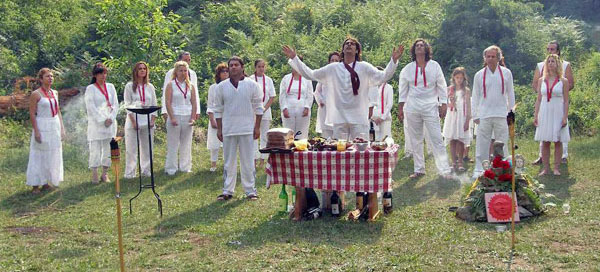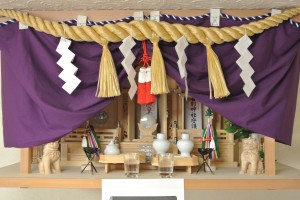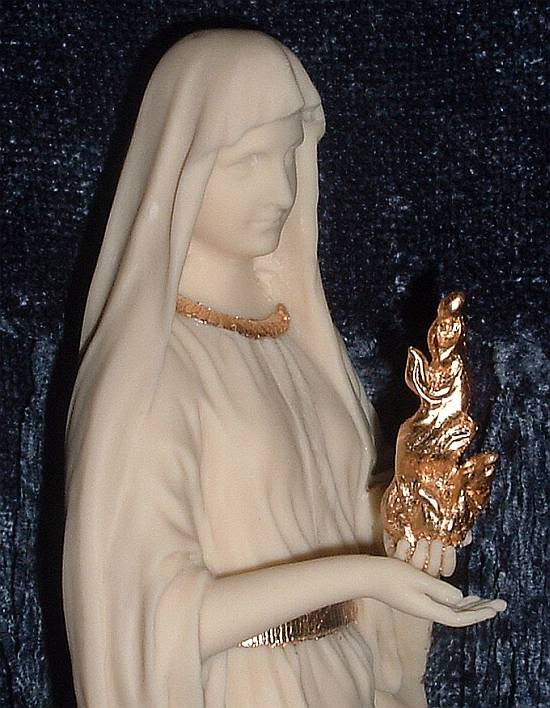
Hellenismos, contemporary style (courtesy Wikicommons)
This is the second part of an article comparing the Greek tradition with Shinto by Erik, author of the now-retired ExecutivePagan blog where some of the material for the article below originally appeared in 2007. (For Part One, click here.)
***********************************************************************************************************************************************
Public Worship
In both traditions, the shrine (basic terms are temenos in Greek, jinja in Japanese – there are other, more specialized, terms in both languages) is traditionally associated with a particular physical/geographic location. It is important here to briefly note that the motivations behind this are different; this is a point I will touch on more deeply in discussing the understanding of the nature of the divine.
According to Burkert, the area of an ancient temenos was generally marked off either with boundary stones, or with a stone wall. A single entrance would be established, where the lustral water would be available. Likewise, the basic layout of a jinja includes a path, usually marked with torii gates, leading to the entrance where the purification basin awaits.
Once purified and inside the sacred precinct, the worshipper of either tradition would still be on relatively familiar ground – an open area in front of the shrine proper, where worship would be conducted. In neither tradition does the worshipper actually enter the shrine. The Greek would have prayed standing up, as modern Hellenists do as well; as I understand it, the Japanese might pray either standing or kneeling.
All of this, of course, is not to obscure the fact that there is a clear and vitally important difference between Hellenic and Shinto worship. To the ancient Greeks (and most modern Hellenists), the basic act of worship is sacrifice. Whether that takes the form of a simple libation, an offering of food or money, or an oath promising some future action – or in ancient times even an animal sacrifice, although those were most often community affairs, and resembled a sort of “sacred barbecue”.
The rituals were often sponsored by either the city or a wealthy citizen, and after the required bits were offered to the gods the assembled worshippers would feast on the rest, essentially sharing the meal with the gods. Sacrifice basically *is* prayer in the Hellenic tradition; both the tradition and modern experience indicate that the gods like to be approached in this way.
In Shinto, with the exception of harvest festivals, it appears that sacrifice is generally not the theme – there may be a gift given to the kami, but it is looked on more as a token of appreciation; the act of prayer is itself the central action of the ritual.
There are also some cultural differences in the physical appointments of the shrine area – the Greeks were heavily into marble, statues and bright colors, while the Shinto aesthetic runs more to unvarnished wood, simplicity and empty space.
Home worship

The Japanese kamidana (literally, spirit shelf) sits high up on the wall so that one looks up to the kami (kami also means 'above' or 'upper')
In both traditions the home is a central locus of worship, although there is at least one difference that may indicate an underlying divergence in approach or emphasis. In the Greek household, or oikos, the hearth was where the family gathered and was the sacred center of the home, where offerings were made. In contrast, the Shinto home has a kamidana that is placed high up on a wall in the main room, so that it is elevated above the people.
The most common act of Hellenic worship was the “first fruits” offering to Hestia at the start of each meal, a small portion of the meal set aside for the goddess; again, a sacrifice (however token), performed as many times a day as the family ate meals. This offering was thrown into the hearth-fire, where the family were gathered, and consumed by the flames and thus by the goddess herself. Modern Hellenists have varied approaches to these basic meal offerings, often dictated by their personal circumstances (since most homes no longer have an actual hearth fire); but the importance of sincerely making the offering is widely acknowledged as one of the most basic expressions of eusebia (piety).
In the basic Shinto home worship scenario, a family member will present the first-fruits offering of clean rice (cooked or not), water and salt, together with acknowledgement of the presence of the kami. At the end of the day, the offerings are removed from the kamidana and frequently eaten with the evening meal, in order to internalize the blessings of the kami. In both cases, it seems to me, there is a common core of relationship and reciprocity – we receive blessings from the gods or kami, and give them offerings and prayer in return (or sometimes vice versa), and thus we stay in right relationship.
I don’t know that my practice has been influenced overmuch in this area by my study of Shinto; this is just one of the things I noticed when I started studying Shinto that piqued my interest and helped convince me that I should look for other similarities.
Final Thoughts
There are other areas of congruence that I wish I could discuss, but that I am limited from by considerations of space and/or the limits of my knowledge. For instance: what are the similarities and differences between local kami of place and Greek nymphs? Could one compare deified humans (Tenjin and Ariadne, for example) in the two faiths? For that matter, how widely divergent is the basic understanding of the nature of humanity in the two traditions? (I suspect that the answer to this last is “pretty far apart”, but that is based on nothing more than a general feeling.) All of these seem to me to be questions worth pursuing.

Hestia, goddess of the hearth, received the first offering at every household sacrifice. Japan too has a kami of the hearth, known as Kojin.
One of the most obvious aspects of polytheism is that we generally accept that other people’s deities are as likely to exist as our own. The ancient Greeks, as is well known, syncretized fairly relentlessly – many of the epithets of the Gods (e.g., Zeus Ammon), reflect the reconciling of “foreign” gods with or as aspects of the Theoi, and in some places during the Hellenistic period this syncretism approached full-fledged synthesis (I am thinking here primarily of Alexandrian Egypt and, to a lesser degree, Judea under the Ptolemies).
Japan also has a long history of syncretism – shortly after Buddhism was introduced in the 6th century, the Japanese began to syncretize Buddhist saints as analogous to kami, a process that culminated a hundred years later in the development of the concept of shinbutsu shugo – the full-blown synthesis of Shinto and Buddhism.7 (There was an interesting article on this a few years ago in the Japan Times. See also here.)
Despite a temporary setback during the period leading up to WWII, when the government suppressed Buddhism in the name of State Shinto, this synthesis persists in many ways up to the present – most Japanese still consider themselves to be both Shinto and Buddhist (or, probably more accurately, to perform both Shinto and Buddhist practices).8
I sometimes wonder what Western civilization might look like today if Christianity had successfully synthesized with the native polytheistic religions of Europe the way that Buddhism did in Japan; sadly, we can only speculate. However, I believe we can, with benefit to ourselves, look to the Japanese religious experience for insight into possible ways to move forward into a brighter, post-Christendom future.
*************************************************************************************************************************************************
[7] http://eos.kokugakuin.ac.jp/modules/xwords/entry.php?entryID=826
[8] http://www.religioustolerance.org/shinto.htm; see the section titled “Number of Adherents”.


I wanted to include this image with the article, but didn’t find it again until just now… I have no idea of the provenance, except that the file name attributes it to “Just Nemisis”, who may or may not be this person:
http://advancedphotoshop.co.uk/user/Nemisis
In any case, this is clearly an artist’s vision of what a Japanese shrine to Dionysos might look like, and it is too perfect not to be included here!
http://thehouseofvines.files.wordpress.com/2012/11/2n_by_just_nemisis-d34rltl.jpg
I wanted to include this picture with the article, but didn’t find it until just now; it’s an artist’s vision of what a Shinto shrine to Dionysos might look like, from a now-deactivated DeviantArt account. I just wish I’d also saved the picture of the thyrsus with the shide attached to it… :)
http://thehouseofvines.files.wordpress.com/2012/11/2n_by_just_nemisis-d34rltl.jpg